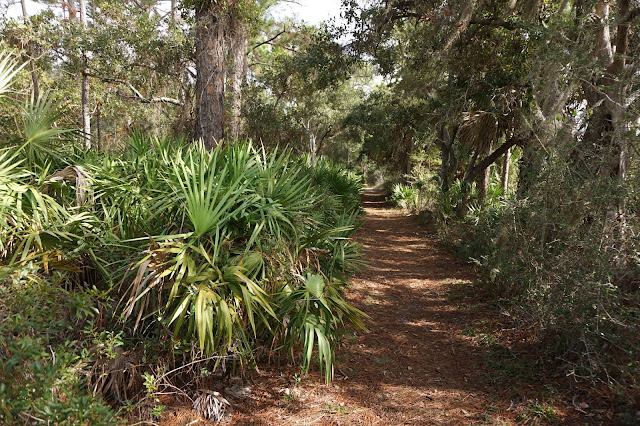However, my thoughts go to times during the mid-20th century when our family traveled to Florida, a place so unique and unusual that my memories are still strongly anchored to that past time. It was a place of flamingos, alligators, snakes, palm trees, and huge deep green vegetation never seen in our mountain home.
And, luckily, today there are still places in Florida to visit
that have maintained that tropical lifestyle.
And, I sincerely hope that such locations remain for other generations
to see.
After leaving the panhandle, we headed to Cedar Key on the
western coast. I had read several travel
articles that defined this area as "Old Florida". And I was not disappointed. First, much of the area around this barrier
island has been protected. Gary and I
spent a day checking out the dirt walking trails and roadways within the Lower
Suwannee National Wildlife Refuge. Those
with kayaks or canoes could explore more beyond these trails, including within
other local refuges.
A 28 foot high shell midden covering over five acres was evidence
of the ancient peoples who lived along the shore.
 |
| Area where midden dune was disturbed |
Walking along the shoreline during low tide, we saw many crabs
traveling in masses from one spot to another.
 |
| March of the crabs... |
And, shore birds were busy getting their share of clams, oysters,
crabs and fish. This was, of course, a
great area for birding and observing other marine life.
Driving in the refuge had its own appeal, with many colonies of
cypress and other water loving plants.
At times it was almost surreal - we could hear many birds, but they were
very elusive and not posing for the camera!
Cedar Key (defined as the island, the collection of several
barrier islands, or the town of Cedar Key) has its own interesting
history. A very early port, and major
commercial center in early Florida history (after the railroad connected it to
the east coast), Cedar Key exported supplies of seafood and timber. Cedar wood was particularly milled into small
slats used for manufacture of pencils (the wood did not splinter!).
Today the town is more known as a "laid-back" place for
creative artists and writers. On our
first night in town, another visitor described Cedar Key as "Key West,
before it became such a popular tourist location" (maybe Hemingway's time?).
The harbor area is a busy place with several good restaurants
(seafood of course), bars and shops to check out. Trying meals at several places was a success
- all great!
To see the other barrier islands considered part of Cedar Key, we
took a great educational boat ride with Tidewater Tours. Since most of the islands are closed to the
public, or only the sand beach is accessible, we enjoyed the tour.
First dolphins decided to ride alongside - but they seemed a bit
camera shy!
 |
| Double-crested Cormorants on old piers |
This was an area with both cormorants (marine) and anhingas (fresh water). Though they may seem similar, we learned they are actually unrelated.
On the other hand, the sea birds must be totally used to the slow
moving boats passing nearby. Most seemed
to be watching us watching them. We did
see some not-so-common birds like the American Oystercatcher and Bald Eagle.
 |
| American Oystercatcher in foreground |
 |
| A bald eagle on "lookout" |
 |
| American White Pelican - much larger than the Brown Pelican - and they "fish" differently! |
We learned that at least a couple of these barrier islands are
receding in size - why? The likely cause
is erosion for the land mass due to early settlers using the wood from the
mangrove trees that are coastal protectors!
One of the islands, Seahorse Key, had some interesting facts: 1) A lighthouse sits on top of an early shell
middens- created dune, at the highest point in the Gulf of Mexico - 48 feet above sea level: 2) the U of FL
leases space on the island to study bird rookeries; and 3) there are 233
cottonmouth (venomous) snakes per acre under the trees with the rookeries. This
creates a symbiotic relationship between the birds and the snakes since the
snakes eat the local arboreal rats!
 |
| Landing area at Seahorse Key with lighthouse in background |
This island is also closed to the public most of the time, with
"events" a few times a year.
Personally, I would not be interested in visiting the rookeries areas...











No comments:
Post a Comment